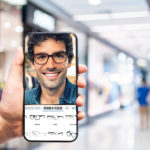
Virtual try-on smooths the patient experience, giving patients the technology they have come to expect when shopping for eyewear. Photo credit: Modern Optical International
By Mark Clark, ABOC, MBA
March 9, 2022
When I consider technologies that simplify practice operations, I think of a meme in which the patient says, “I have checked in on the app, checked in at the kiosk and checked in at the front desk. Is there another way I can check in?” This is a funny meme, but it is not entertaining to patients. Technologies that are implemented must check both of these boxes for success: Easy for the patient, easy for the office.
Here are three technologies that accomplish both of those goals.
Patient Messaging Service
Patient messaging technologies increase retention and reduce no-shows, which will greatly improve your bottom line. For those reasons, text messaging patients to confirm upcoming appointments is now standard for most physicians. It has been said that “texting is the new e-mail.” Patients have come to expect this from all of their providers, and now want to get communications from their eye doctors this way too. This technology certainly checks the box for being easy for the patient.
And while this one may seem like a “no-brainer,” there are key considerations when selecting a provider for patient messaging: HIPAA compliance, EHR integration and the ability to collect patient cell phone numbers and then send invitations to patients to “opt-in” to receive messages from your office. Protected Health Information (PHI) will always be subject to HIPAA privacy law.
A practice owner must also consider how well a particular messaging service will integrate with their current EHR system in order to check the second box (easy for the office). Consider whether it can automate recalls, check-in patients, send product pick-up notifications and payment reminders. These tasks are a huge burden on staff. If properly integrated, a messaging system can save hours of staff work each day.
If you are going to implement a messaging system, you will need to have begun to collect and identify cell phone numbers in your EHR. Even if you are on the fence about current technology integration, you should begin immediately to update your records. Since the cycle of many patient visits can be as long as three years, it may take even longer to slowly add this data to your records at each appointment visit. This is like the old saying, “The best day to plant a tree is yesterday, the next best day is today.”
Virtual Try-On
Current virtual try-on (VTO) providers in the market tout an impressive 10-15 percent increase in capture rate. But if you have tried older technologies, you might be thinking there is no way it can be easy for both the patient and the office. Fortunately, this is a technology that is evolving each day at the speed of light. Fueled by interest in the metaverse, these technologies will constantly improve and become more user friendly and mainstream.
There are key questions to ask when considering a virtual try-on: Does my staff have to constantly add new inventory to it? Is it easy for the patient to navigate? Does it help reduce the fitting time of the patient?
Inventory in most optical stores is far too dynamic to manage an e-commerce site and the uploading of product images. Your goals should be to have a simple, static selection in your VTO that you review once or twice a year. Make sure the selection is broad enough to accomplish the goal of helping the patient comprehend–and act on–their style.
Next, the VTO should be simple for the patient to navigate. They should be able to easily locate men’s, women’s and children’s styles. Remember that the patient is on an e-commerce or frame discovery journey in your VTO without the aid of an optician. The VTO should serve as another optician to help guide them through the frame discovery process to create a meaningful and enjoyable journey.
Other Articles to Explore
Lastly, the VTO should reduce the time spent in your office. To accomplish this, the VTO must be accessible. This goal ties in with the first technology we discussed, patient messaging. When used in conjunction with outbound text messages, a VTO can be a powerful engagement tool. Remind your patients to shop ahead of time in your VTO. Many new VTO experiences allow the user to also send their favorite styles list to the office. Data from The Vision Council suggests that shoppers who regularly purchase locally also shop online ahead of their visit.
To reduce time in the dispensary, the VTO must provide an accurate representation of the frame and its size. This is often overlooked. Imagine how counterproductive it would be to have dozens of patients coming to their appointments expecting to buy a frame that will never fit. What was meant to save time has then cost the optician and the patient valuable time. While most technologies on the market do not have the ability to offer a fitting that is “true-to-life” sizing, there are some VTO experiences that do.
You may not see an immediate impact from implementing a VTO, but you may prevent many patients from completing a sale online elsewhere. In time, sales from those patients, who stuck with you rather than buying elsewhere, will add up to increased profitability.
Patient Portal
The patient portal is another technology mainstream now in most of healthcare, but still experiencing a low adoption rate in the optical industry. Some optical EHR platforms are now offering a patient portal as an integrated option. This technology is new to eyecare, but will be advancing more quickly thanks to simple add-on modules from the most popular EHR platforms.
In fact, I expect most EHR platforms to soon have patient portal functionality available. Many patient portal platforms exist in healthcare, but they often do not integrate easily with an optical EHR or practice management system. So, while we know that a portal makes it simple for a patient to access records, to also simplify office operations, I recommend keeping your eyes peeled for a patient portal module from your current provider. Or if your office is currently considering an EHR conversion, choose one that already offers a portal, as well as a built-in, HIPAA-compliant patient messaging system. Once successfully implemented, your front desk may be relieved of the burden of answering record-related phone calls and e-mails.
An office must also consider the ramifications of a patient accessing their prescription without an optician to attempt to capture a sale. If at all possible, make sure that your patient portal is also the easiest gateway to ordering contact lens replacements and glasses. Your portal should have links to your website, or ordering page, that make it convenient for patients to keep their business with you. Consider customized messaging within the portal such as, “Thank you for confirming your appointment. Begin browsing styles in our VTO HERE.” The office may also want to restrict the portal to appointment information, necessary forms and health records to keep the staff involved with patient care for ordering.
Bottom Line: New Technologies Can Make Life Easier for Both You & Your Patients
The technologies outlined in this article are a win-win for patients and practice. If a technology you are considering would make your life better, but not that of your patients, or vice versa, don’t implement it. Creating a profitable practice requires using technologies that increase practice efficiency while enhancing the patient experience.
 Mark Clark ABOC, MBA, is a former practice owner with 20 years in the optical industry. He has an MBA in Healthcare Administration and is Vice-President of Digital Services at Modern Optical International. To contact him: mclark@modernoptical.com
Mark Clark ABOC, MBA, is a former practice owner with 20 years in the optical industry. He has an MBA in Healthcare Administration and is Vice-President of Digital Services at Modern Optical International. To contact him: mclark@modernoptical.com

























